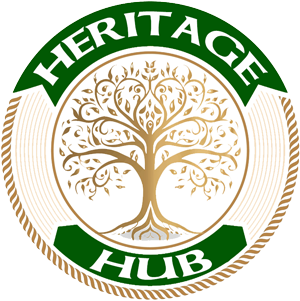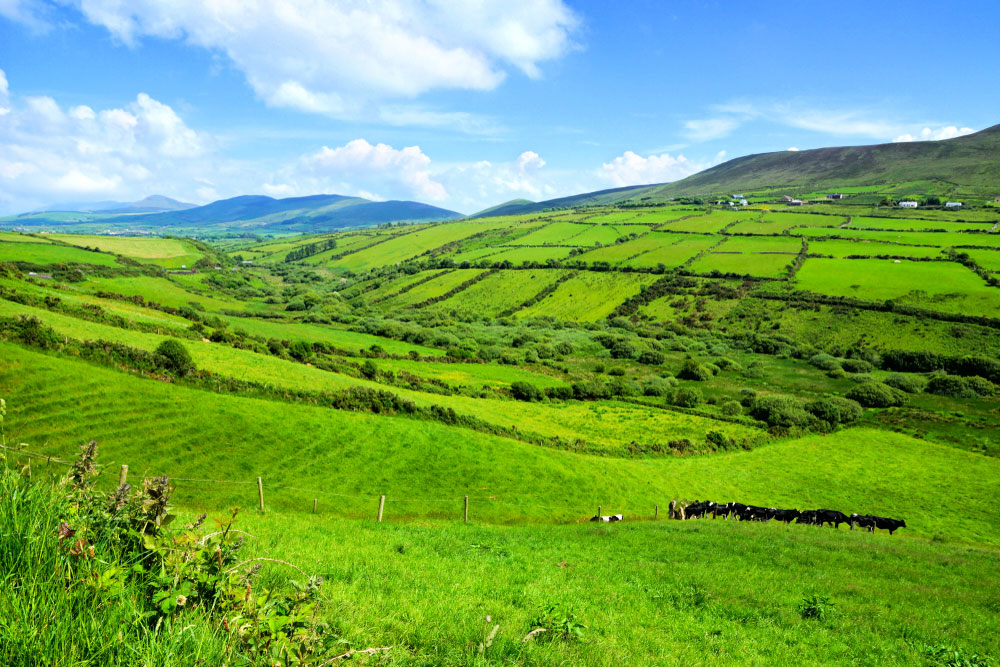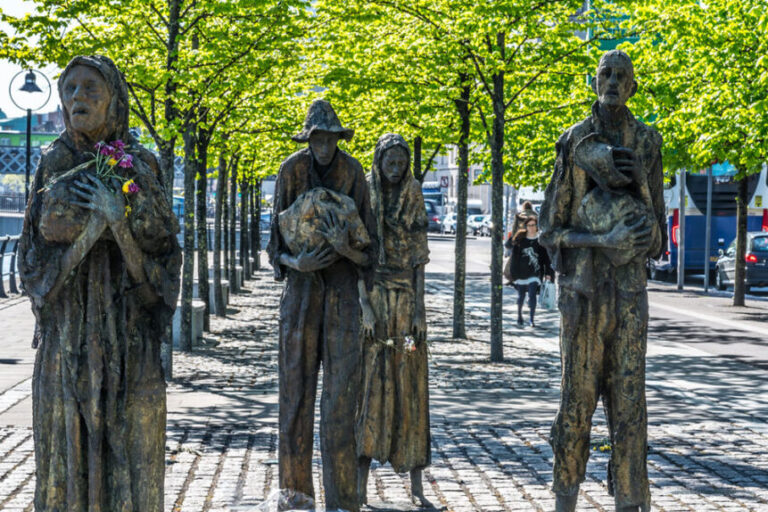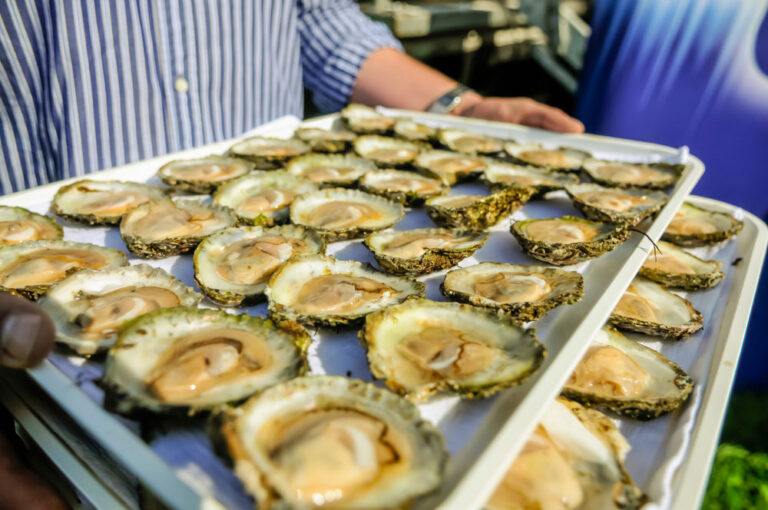The Roots of Farming – Ireland’s Earliest Farmers
Ireland’s farming story begins thousands of years ago, long before written records, before castles dotted the landscape or churches rose over village greens. It is, at heart, a tale of people and place—of how the land shaped the people and how, in turn, the people learned to live from the land.
In the earliest days of Irish civilization, during the Neolithic period (roughly 4000 BC), Ireland’s first farmers arrived by boat, bringing with them seeds, tools, and a new way of life. These early settlers cleared parts of the native forest to grow cereals such as barley and emmer wheat. They also raised livestock—mainly cattle, sheep, and pigs—marking a dramatic shift from the hunter-gatherer lifestyle that had come before.
The land they found was rich and green, covered in dense woodland, with fertile soil in the river valleys and plains. Ireland’s mild, wet climate—although often a challenge—also meant a longer growing season than in some other parts of Europe. The newcomers built stone dwellings and burial monuments, many of which, like Newgrange and Poulnabrone Dolmen, still stand today as silent witnesses to these ancient farming communities.
Life was far from easy. The unpredictable weather could bring weeks of rain or unexpected frosts. Crops might fail. Herds could be lost. But these early farmers adapted. They created tools from stone and later bronze, learned to rotate their crops, and worked together in family groups or tribal communities to share resources and labor. Over generations, a deep and sacred connection to the land grew—an awareness that the earth was not just a provider, but a partner in survival.
In Irish mythology and oral tradition, this bond between people and land was central. The goddess Danu was seen as the mother of the earth, and agricultural fertility was associated with the health of the kingdom itself. A good harvest wasn’t merely a practical concern—it was a sign that balance and harmony had been maintained between the people and the spiritual forces of nature.
As centuries passed and farming knowledge deepened, Irish communities became more stable, giving rise to structured settlements and local trade. Dairy products such as milk, butter, and soft cheeses became vital staples. Cattle in particular weren’t just a food source—they were a symbol of wealth and status, often used as a form of currency or dowry. The early Irish legal system, the Brehon Laws, included extensive rules around the care, value, and ownership of livestock, underlining just how central farming had become.
By the Iron Age, farming in Ireland had become highly organized. Fields were enclosed using stone walls or wooden fences, livestock was bred selectively, and tools of iron replaced older ones of bronze and stone. With each generation, knowledge was passed down, shaped by the seasons and the wisdom of the elders.
And so, through hardship and harvest, myth and memory, farming took root in Ireland—not just as an economic necessity but as a way of life. These early beginnings laid the groundwork for a resilient tradition of working the land that continues to this day.
Invasions and Innovations – The Changing Face of Irish Agriculture
As Ireland’s ancient farming communities matured and spread across the island, they built a system of agriculture deeply connected to the land and guided by tradition. But with the arrival of outside forces—the Vikings, Normans, and later the English—this way of life began to shift. Each wave of invaders left its mark, bringing new tools, crops, systems of land ownership, and challenges to the people of the soil.
The Vikings: Raiders and Traders
The Viking incursions, beginning in the late 8th century, are often remembered for their violent raids on monasteries and coastal settlements. Yet over time, many Viking settlers established permanent communities in places like Dublin, Waterford, and Limerick. They introduced new trade routes that connected Ireland with the broader Norse world, and with that came the exchange of goods—including foodstuffs and farming knowledge.
The Vikings also brought with them improved preservation techniques, particularly salting, smoking, and pickling—methods that were vital in extending the shelf life of fish and meats. While they didn’t drastically alter Irish farming at its roots, they did influence the way surplus food was stored, traded, and valued.
The Normans: Structure and Strategy
The Norman invasion of Ireland in the late 12th century had a far deeper and more lasting impact on Irish agriculture. These new lords brought with them a more hierarchical and feudal system of land ownership. Where land had once been held communally or passed through local kinship groups, it was now divided into manors and granted to Norman nobles who imposed rents and obligations on the Irish tenants.
With them, the Normans introduced new agricultural practices, including more widespread use of ploughs pulled by oxen and the cultivation of legumes to replenish soil fertility. They built mills and market towns, formalizing trade and encouraging the sale of surplus produce. They also introduced new breeds of cattle and horses, and developed enclosed fields, which contrasted with the more open, communal grazing systems of earlier Ireland.
Under Norman influence, Irish farming became more organized and commercial—but also more controlled. Native Irish farmers often became tenants on land their families had once freely roamed, and their relationship to the soil grew more strained under foreign rule.
The English: Enclosures and Exports
Over the following centuries, English influence in Ireland deepened, culminating in the full colonization of the island. This period brought major changes to farming—some beneficial, others devastating.
Most notably, the English introduced the enclosure system, where common lands were divided into private holdings with stone walls or hedges. This allowed for more intensive farming practices and better management of livestock, but it also displaced many Irish peasants who relied on shared land to survive. Enclosures favored large landowners and created a growing class of landless laborers.
One of the most significant additions during this time was the potato, introduced in the 16th century. Its high yield and nutritional value made it an ideal crop for the Irish climate and soil. By the 18th century, it had become the primary food source for much of the population, especially the rural poor. While this increased food security in the short term, it also made Ireland dangerously dependent on a single crop—a vulnerability that would prove catastrophic during the Great Famine.
At the same time, many of the best Irish farmlands were devoted to exports—grain, beef, butter, and wool—sent to England and beyond. This created a system where Irish people were often hungry in a land that produced more than enough food. The wealth generated by agriculture largely bypassed the rural poor, who bore the burden of working the land but reaped few rewards.
Through invasion and upheaval, Irish farmers adapted and endured. They learned new techniques, worked under foreign systems, and clung to their connection with the land even as it was taken from them. Their resilience during this era laid the foundation for future struggles—and future triumphs.
The Great Famine and the Fight for the Land
Few chapters in Irish history have left as deep and lasting a scar as the Great Famine. In the mid-19th century, farming in Ireland reached a breaking point. While the country appeared green and bountiful, underneath lay a fragile agricultural system built on inequality, dependence, and desperation.
The Rise—and Risk—of the Potato
By the early 1800s, the Irish population had grown rapidly, and the potato had become the primary food source for the vast majority of people, especially tenant farmers and laborers. A small patch of land could yield enough potatoes to feed an entire family, making it the ideal crop for those with little to live on.
But this heavy reliance came at a cost. In 1845, a silent enemy arrived: Phytophthora infestans, a fungal blight that turned healthy potatoes to black, inedible rot. The blight swept across the country, and with it came famine.
A Starving People in a Land of Plenty
What made the famine so devastating wasn’t just the crop failure—it was the system. Much of the best land was still controlled by landlords, many of them absentee, and vast amounts of food continued to be exported while the local population starved. Tenant farmers, who had already been living at the edge of survival, were evicted when they couldn’t pay rent. Some died on the roads. Others crowded into poorhouses or boarded ships in search of a better life abroad.
Between 1845 and 1852, more than one million people died, and at least another million emigrated, many to North America and Australia. Whole villages were emptied. Fields lay fallow. The population of Ireland plummeted and would not recover for over a century.
Out of Tragedy, a Turning Point
Yet even in the midst of such devastation, change began to take root. The famine highlighted the deep injustice and instability of the Irish land system. A new movement began to stir—one that demanded land reform, tenant rights, and fair treatment for those who actually worked the soil.
By the latter half of the 19th century, a series of Land Acts gradually began to shift ownership from landlords to tenants. The Land War of the 1870s and 1880s, led by groups like the Irish National Land League, used organized resistance and public pressure to demand better conditions. Slowly but surely, the dream of owning the land one farmed began to become a reality for Irish families.
The famine also left a deep cultural legacy. It was a collective trauma that would echo through generations, shaping Ireland’s national identity and its people’s relationship with the land. Farming was no longer just a livelihood—it became a symbol of resilience, remembrance, and the right to exist with dignity on one’s own soil.
From ashes and grief, Irish agriculture began to rise again—this time on a foundation that placed more power into the hands of those who tilled the earth. The lessons of the famine would shape everything that came after.
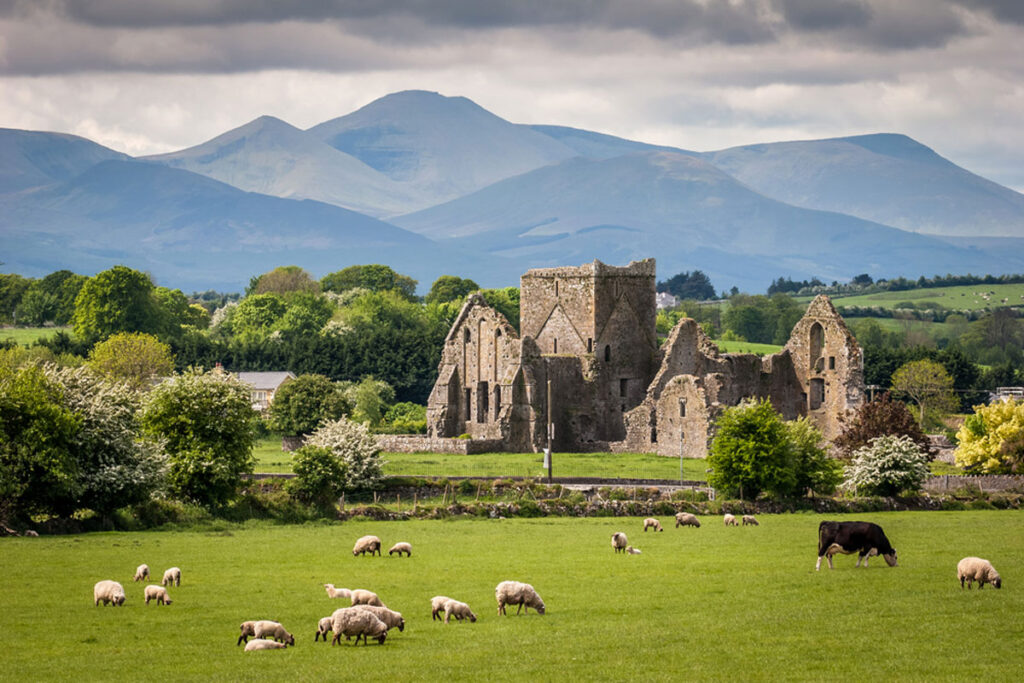
The 20th Century Farm – From Independence to Innovation
As Ireland emerged from the shadow of the Great Famine and stepped into a new century, farming remained the lifeblood of the country—but now the landscape was beginning to change. The 20th century brought independence, new opportunities, and new challenges. From horse-drawn ploughs to mechanized tractors, from small tenant plots to government-supported cooperatives, the Irish farm underwent a quiet revolution.
A Nation Born, A Land Reclaimed
With the founding of the Irish Free State in 1922, the land question took on renewed urgency. Generations of struggle had finally borne fruit, and a major focus of the early governments was ensuring land ownership for ordinary Irish farmers. Through the Land Acts, tens of thousands of Irish families were able to buy the land they worked, often with government assistance.
This shift from tenancy to ownership was monumental. It transformed farming from a survival activity into a long-term investment and a point of pride. Farmers could now make decisions for themselves, plan for the future, and pass down land to their children with security.
The Co-Op Movement and Rural Life
The early 20th century also saw the rise of agricultural cooperatives, which helped small farmers pool resources, share equipment, and collectively market their produce. Creameries sprang up in villages and towns, allowing farmers to process and sell butter, cheese, and milk locally. These co-ops not only improved efficiency and income—they also fostered a strong sense of community.
Farmers joined rural organizations like Macra na Feirme (Young Farmers) and the Irish Farmers’ Association (IFA), which became powerful voices advocating for rural issues. Agricultural shows and county fairs became important events in rural life, celebrating the best livestock, produce, and craftsmanship from local communities.
Modernization and Machinery
As the century progressed, traditional farming methods slowly gave way to modernization. The horse was replaced by the tractor. Hay was no longer cut by scythe but by machine. New fertilizers, pesticides, and improved breeding techniques increased yields and efficiency. Farmers began adopting more scientific approaches to crop rotation and animal husbandry.
Government support also played a key role. Agricultural training programs were introduced, rural electrification spread across the countryside, and subsidies helped farmers weather hard times. Still, small farms often struggled, and many rural families sent their children to the cities—or abroad—for better opportunities.
Joining the European Community
Perhaps the most significant turning point came in 1973, when Ireland joined the European Economic Community (EEC)—now the European Union (EU). Membership opened up access to funding through the Common Agricultural Policy (CAP), which provided grants, price supports, and investment in rural infrastructure.
This allowed many farmers to modernize their operations, improve their land, and increase their production. But it also brought regulation, competition, and new market pressures. Farms had to adapt quickly to a more globalized world.
The 20th century brought both progress and pressure. While mechanization and modernization improved farm output and rural living standards, it also forced many smallholders to scale up or step away. Through it all, Irish farmers continued to evolve—rooted in tradition, yet always reaching toward the future.
Farming in Ireland Today – Sustainability, Technology, and the Spirit of the Land
Today, farming remains one of the most vital threads in the fabric of Irish life. While fewer people now work directly on farms, agriculture continues to shape Ireland’s economy, culture, and global identity. It’s no longer just about surviving the seasons—it’s about producing quality food sustainably, embracing innovation, and preserving a heritage built over millennia.
A Modern Agricultural Landscape
Modern Irish farms are a dynamic blend of the old and the new. You’ll still find stone walls and lush green fields, but they now exist alongside GPS-guided tractors, robotic milking machines, and climate-smart crop systems. Precision agriculture—using data to monitor soil health, water levels, and crop yields—has transformed the way farmers work, helping them maximize efficiency while reducing environmental impact.
Ireland’s mild climate, ample rainfall, and rich soil continue to give it a competitive edge in producing high-quality dairy, beef, lamb, and crops. The country exports food to over 180 nations, with Irish butter, cheese, and grass-fed beef recognized around the world for their taste and quality.
Sustainability and the Green Future
One of the defining challenges of today’s agricultural world is the climate crisis, and Irish farmers are on the front lines of the push toward sustainability. Many are adopting low-emission slurry spreading (LESS), investing in renewable energy like solar and wind, and planting hedgerows and cover crops to support biodiversity and capture carbon.
Organic farming is on the rise, and more consumers are choosing locally sourced, chemical-free produce. Meanwhile, programs like Origin Green, a national sustainability initiative, encourage producers and food companies to set measurable targets for reducing waste and promoting eco-friendly practices.
Still, the journey isn’t without tension. Farmers face pressure to reduce emissions, protect water quality, and diversify land use—while also trying to stay profitable and competitive in a rapidly changing market.
The Rural Heartbeat
Despite modernization, farming in Ireland retains a powerful emotional and cultural resonance. For many families, the land isn’t just a business—it’s an inheritance, a legacy, and a lifestyle. The connection to the earth runs deep in the Irish psyche. Rural communities may be smaller than they once were, but they remain vibrant, resilient, and closely tied to the land.
Traditional values of hard work, community, and stewardship still guide many Irish farmers. Events like the National Ploughing Championships, agricultural shows, and local food festivals celebrate rural life and showcase the continued importance of farming to the nation’s identity.
A New Generation, A Shared Legacy
Encouragingly, a new generation of young farmers—both men and women—is stepping up. Many are educated in agricultural science, trained abroad, or returning to the land with fresh ideas. They are tech-savvy, environmentally conscious, and eager to honor the past while embracing the future.
Farm diversification is also growing, with many Irish farms branching out into tourism, artisan food production, equine services, and ecological restoration. From farm-to-fork dining experiences to eco-farms and community gardens, the Irish countryside is becoming a space of innovation, storytelling, and shared experience.
In every furrowed field, in every barn and pasture, the story of Ireland continues to unfold. Farming today is no longer just about food—it’s about sustainability, identity, connection, and care. It’s the story of people who continue to rise before dawn, in wind and rain, to work the land their ancestors walked.
Farming in Ireland has always been more than a job—it is a way of life. And as the island moves forward into an uncertain future, one thing remains constant: the Irish spirit endures, rooted in the land, reaching toward tomorrow.


